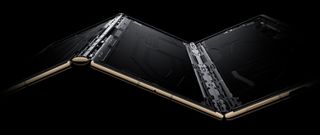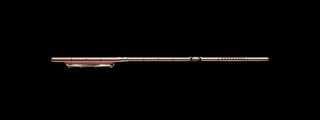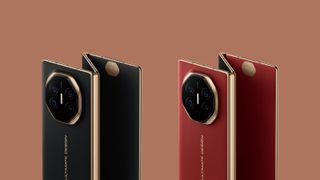China’s Huawei has just announced a tri-folding smartphone, reportedly the world’s first pocket-sized device to use such a system. The Mate XT is the size of an iPad or similar tablet, at 10.2 inches, with the leftmost segment forming a normal phone-sized display when closed.

(Image credit: Huawei)
It’s a logical design, as it combines the familiarity and convenience of a supersized 6.4-inch smartphone with the full-screen capabilities of a tablet. To achieve the triple-fold, the company has devised an incredibly complex hinge mechanism, likely to strike fear into the hearts of smartphone repair shops. The back of the phone is crafted from genuine leather, available in black or red, and the entire device remains remarkably thin even when fully folded, at 12.8mm (versus the Pixel 9 Fold Pro’s 10.5mm), and light.

Huawei Mate XT hinge structure
(Image credit: Huawei)

An ultra-thin, triple-folding phone: the Huawei Mate XT
(Image credit: Huawai)
Complexity isn’t the only downside. Since 2019, Huawei has been banned from using Google’s Android operating system and associated apps. Not only does this alienate large segments of the population (mostly Western consumers), it also effectively puts the company’s devices out of the competition when it comes to running both cutting-edge AI software and familiar, everyday apps. Huawei’s HarmonyOS isn’t a direct replacement for Android, and while the new phone promises some AI capabilities, the software isn’t as polished as the hardware.

Huawei Mate XT has a 10.2-inch display when fully unfolded
(Image credit: Huawei)
That’s a shame, because the latter exudes quality. Devices like the recent impressive MatePad Pro 13.2-inch tablet really do encourage you to compromise and find workarounds for your favorite apps. Only time will tell, though, whether this costly three-pronged approach will ever be embraced by other companies. For now, this is perhaps the most premium smartphone of them all, with the top-of-the-line model (with 16GB of memory and 1TB of storage) coming in at CN¥23,999, or $3,390 or €3,050 euros).

Huawei Mate XT is available in two colors
(Image credit: Huawei)
Google’s latest Pixel 9 Fold Pro takes our top spot in the admittedly modest foldable category, with Samsung and Honor hot on its heels, and the rumor mill continues to hint at some form of Apple foldable in the near future.

The screen structure of the Huawei Mate XT
(Image credit: Huawei)
Remember the Razor Wars? In the 90s, razor manufacturers increased the number of blades on their disposable pod systems from two to three (the iconic Gillette Mach 3). In 2003, Schick-Wilkinson countered the Sword with the Quattro, a four-blade shaving system. In 2006, Gillette hit back with the Fusion5 Razor. Others have since moved to six. Are smartphone screens headed the same way?
Huawei Mate XT, more information and available at Consumer.Huawei.com



/cdn.vox-cdn.com/uploads/chorus_asset/file/25615394/Huawei_Mate_XT_hands_on_hed.jpg?w=445&resize=445,265&ssl=1)